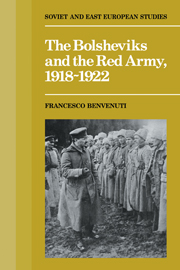Book contents
3 - Reorganization on the battlefield
Published online by Cambridge University Press: 03 October 2009
Summary
The first stage: the eastern front
The creation of regular army units, anticipated in the decrees of the spring, was finally sanctioned by the 5th Congress of Soviets in July 1918. The Congress announced the end of ‘improvised and haphazard’ squads, and proclaimed the centralized leadership of the armed forces. It also ratified the institution of commissars and indicated the need for a regime of discipline, for which both commanders and commissars would be held responsible. In his conclusions, Lenin lent his authority to the first steps taken in that direction, by ridiculing the illusion (which he attributed above all to the Social Revolutionaries) that ‘a regular Imperialist Army’ could be defeated by ‘guerrilla detachments’. Those who advocated the formation of such detachments argued that there were insufficient time and resources to organize a more powerful force.
This view was not unfounded. It was a reflection of the military situation of the new Republic. Throughout the early summer months, the Red Army remained in fact a numerically small body with ill-defined structures, owing to the lack of any elementary coordination of the activity of the various organs of the High Command. Autonomous regional nuclei of armed detachments still existed alongside those trained and sent out by the centre. It was only the ‘baptism of fire’ constituted by the battle for Kazan' that made it possible and imperative to implement the theoretical principles that the Soviet military authorities had been asserting ever since March. In the Urals, the Red forces once again came up against an adversary superior in both weaponry and training.
- Type
- Chapter
- Information
- The Bolsheviks and the Red Army 1918–1921 , pp. 38 - 64Publisher: Cambridge University PressPrint publication year: 1988



